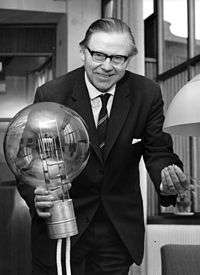Gunnar Sträng
| Gunnar Sträng | |
|---|---|
 | |
| Folkhushållningsminister | |
|
In office 1947–1948 | |
| Minister for Agriculture | |
|
In office 1948–1951 | |
| Preceded by | Per Edvin Sköld |
| Succeeded by | Sam B. Norup |
| Minister for Social Affairs | |
|
In office 1951–1955 | |
| Preceded by | Gustav Möller |
| Succeeded by | John Ericsson i Kinna |
| Minister for Finance | |
|
In office 1955–1976 | |
| Preceded by | Per Edvin Sköld |
| Succeeded by | Gösta Bohman |
| Personal details | |
| Born |
December 23, 1906 Lövsta, Sweden |
| Died | March 7, 1992 |
| Political party | Social Democratic Party |
| Occupation | Politician |
Gunnar Georg Emanuel Sträng (December 23, 1906 - March 7, 1992) was a Swedish Social Democratic politician, most known for being Sweden's longest serving Minister for Finance.
Sträng grew up in a working-class family in Lövsta, today a part of Stockholm Municipality. After finishing school he started to work as a gardener. In 1927 he joined the local branch of the garderners' union and was soon elected to the board as secretary. A few years later, in 1932, he was elected as an official to the national union organisation for agricultural workers, with the task of recruiting new members in order to force the employers to consent to collective bargaining. In 1938, he was elected vice chairman of the trade union and the following year he succeeded the chairman.
Through the Swedish Trade Union Confederation Sträng was appointed as a representative on various state committees, and July 6, 1945, Prime Minister Per Albin Hansson offered him to be Minister for Agriculture. Sträng turned him down, but a few days later he accepted to be a member of the cabinet, although not with the title of minister. In 1947 Sträng was made "Conservation Minister" (folkhushållningsminister) and implemented harsh measures, such as petroleum rationing. The following year he accepted to be Minister for Agriculture, and in 1951 he became Minister for Social Affairs. During this period, health insurance was made mandatory through a state system.
September 12, 1955, Gunnar Sträng was made Minister for Finance. One of the major reforms during his time in office was the introduction of value added tax. The joint taxation of spouses was abolished, a change that made it more economically attractive for women to seek paid employment. The Social Democrats, together with the Centre Party also engineered the Swedish newspaper subsidy system, created to support the smaller newspapers in a region in order to prevent "newspaper death" and preserve multitude.
When the Social Democrats did poorly in the 1956 elections, party leader Tage Erlander offered to step down and Sträng was offered to take over the leadership - but refused. He remained Minister for Finance until the Social Democrats lost power to the centre-right in the 1976 elections.
Gunnar Sträng was generally regarded as economically prudent. He was known for wearing "both suspenders and a belt", also a striking symbol of his careful general attitude. He was also known to have a photographic memory and was able to quote the figures from the national budget by heart in his annual presentations on television and made this dull subject something of a popular event. For the Swedish people he was very highly respected as an trustworthy national householder ( rikshushållare ) of the Swedish economy. His powerful position both inside and outside of the Cabinet, led to that his subordinate staff inside the Finance Ministry giving him the nick-name "Gustav Vasa" .
| Preceded by Per Edvin Sköld |
Minister for Finance 1955–1976 |
Succeeded by Gösta Bohman |